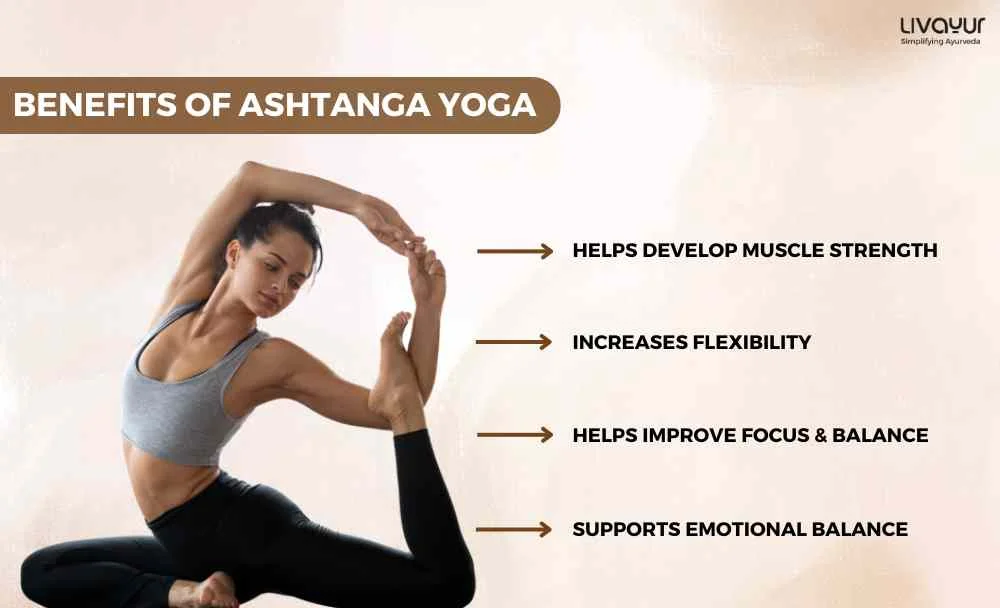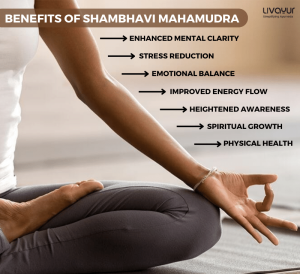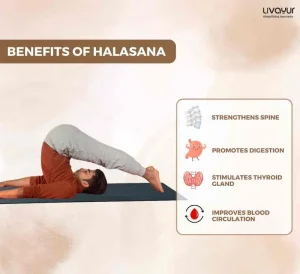This article is reviewed by an expert

Yoga, particularly Ashtanga Yoga, holds a significant place in the world of wellness and self-discovery. Also known as the Eight Limbs of Yoga, it is one of the most popular types of yoga practised throughout the world.
Let’s find out more about Ashtanga Yoga in this article.
History of Ashtanga Yoga (1)
Ashtanga Yoga first found a formal expression through the revered sage Patanjali, who compiled the essence of yoga into a comprehensive philosophy known as the Patanjali Yoga Sutra. This seminal text outlines the eight limbs of yoga, each of which plays a vital role in guiding individuals towards physical, mental, and spiritual well-being.
The Eight Limbs of Ashtanga Yoga (2)
- Yama (Ethical Standards and Integrity)
The first limb, Yama, revolves around ethical standards and how you conduct yourself in life. It encompasses principles that promote harmony and compassion towards others. The five Yamas are:
- Ahimsa: Nonviolence
- Satya: Truthfulness
- Asteya: Non-Stealing
- Brahmacharya: Continence
- Aparigraha: Noncovetousness
By practising these ethical guidelines, you can cultivate a sense of integrity, respect, and empathy in your interactions with others.
- Niyama (Self-Discipline and Spiritual Observances)
The second limb, Niyama, focuses on self-discipline and spiritual observance. It encourages regular practices that nurture your spiritual growth. The five Niyamas are:
- Saucha: Cleanliness
- Samtosa: Contentment
- Tapas: Spiritual Austerities
- Svadhyaya: Study of the Self and Sacred Scriptures
- Isvara Pranidhana: Surrender to a Higher Power
Incorporating these observances into your lives helps cultivate self-discipline, contentment, and a deeper connection with your spirituality.
- Asana (Postures for Physical and Mental Well-being)
Asanas, the third limb, refer to the physical postures practised in yoga. These postures are not only about physical fitness but also about nurturing the body as a temple of the spirit. Through the practice of asanas, you can develop discipline, concentration, and the ability to be present at the moment.

- Pranayama (Breath Control for Vitality)
The fourth limb, Pranayama, involves breath control techniques that harness the connection between breath, mind, and emotions. By practising Pranayama every day, you can rejuvenate your body and extend your life force.
Integrating breath control exercises into your yoga routine also enhances your physical vitality and promotes overall well-being.
- Pratyahara (Sensory Withdrawal for Self-Reflection)
Pratyahara, the fifth limb, invites you to withdraw your awareness from the external world and turn inward. By detaching from your senses, you can objectively observe your cravings and habits, gaining insight into yourselves. This stage of self-reflection also facilitates personal growth and transformation.
- Dharana (Concentration for Mental Focus)
Dharana, the sixth limb, involves the practice of concentration. By eliminating external distractions, you can cultivate the ability to focus the mind on a single point. The concentration prepares you for deeper stages of meditation and helps develop mental clarity and focus.
- Dhyana (Meditation for Mindful Awareness)
Dhyana, the seventh limb, refers to meditation or contemplation. In this stage, your concentration evolves into a state of mindful awareness, where the mind becomes quiet and thoughts subside. Through regular meditation practice, you can cultivate a profound connection with your inner self and experience a sense of oneness with the universe.
- Samadhi (Ecstasy and Transcendence)
The eighth and final limb, Samadhi, represents a state of ecstasy and transcendence. In this stage, you merge with your point of focus, transcending the Self altogether.
Benefits of Ashtanga Yoga (2)
Ashtanga Yoga, with its focus on the eight limbs of yoga, offers numerous benefits that enhance both physical and mental well-being. Let’s explore some of these benefits here.
Physical Strength
Primary Benefits: Ashtanga Yoga helps develop muscle strength and increases flexibility and control.
Secondary Benefits: In addition, it also improves core and arm strength and enhances stamina and endurance.
Cardiovascular Health
Primary Benefits: Ashtanga Yoga helps lower heart rate, blood pressure, respiratory rate and cortisol levels in the body, all of which contribute to improved cardiovascular health.
Secondary Benefits: Furthermore, Ashtanga Yoga also helps regulate body weight and increase blood flow to vital organs, which helps not only prevent heart diseases but also enhance overall health.
Coordination
Primary Benefits: Ashtanga Yoga helps improve focus, balance, and coordination.
Secondary Benefits: Additionally, it also enhances body awareness and movement flow by developing a sense of rhythm through intense asana sequences.
Emotional Health
Primary Benefits: Ashtanga Yoga helps cultivate emotional and mental flexibility and supports emotional balance and purification.
Secondary Benefits: Moreover, it also helps promote a deeper understanding of the mind-body connection.
Mental Health
Primary Benefits: Ashtanga Yoga shifts the body’s balance from a fight-or-flight response to a relaxation response. It also helps alleviate mental health issues like depression, anxiety, stress, and insomnia.
Secondary Benefits: In addition, Ashtanga Yoga also supports breath awareness and mindfulness, allowing for the alteration of unwanted behaviour patterns.
Spiritual Well-being
Primary Benefits: Ashtanga Yoga awakens the spiritual self through the practice of specific sequences.
Secondary Benefits: It also teaches how to interact with the external world and relate to the mind, facilitating a sense of inner union and deep realisation.
Asanas or Poses in Ashtanga Yoga (2)
https://www.shutterstock.com/image-photo/young-healthy-beautiful-woman-sportive-top-1657474324
Ashtanga Yoga features a structured progression of asanas, forming the core of the practice. You have to master each asana gradually, ensuring systematic development of physical and mental capabilities. Some key aspects of asanas in Ashtanga Yoga include:
Chained Movements: Ashtanga Yoga incorporates vinyasas, which are fluid and dynamic movement sequences to each asana. These vinyasas create a continuous flow and make Ashtanga a form of aerobic exercise.
The Tristana: The Tristana is a distinguishing aspect of Ashtanga Yoga, focusing on the coordinated attention to asana, breath, and gaze. This threefold approach aims to cultivate concentration, serving as a stepping stone to meditation.
Controlled Breathing: Asanas in Ashtanga are synchronised with either inhalation or exhalation, and each pose is held for a specific number of breaths. This deliberate integration of breath and movement fosters controlled breathing practices.
Gazing Points: Each asana and vinyasa in Ashtanga has a specific gazing point, such as the hands or a fixed point in space. These gazing points help reduce external distractions and enhance concentration.
The Final Takeaway
Ashtanga Yoga offers a comprehensive approach to physical, mental, and spiritual well-being through its eight-limbs practice. It offers numerous physical, mental and emotional benefits which can help transform your health holistically.
Disclaimer: The information provided here is for general information and not meant to substitute any medical advice. Please consult your doctor for appropriate medical consultation.






















